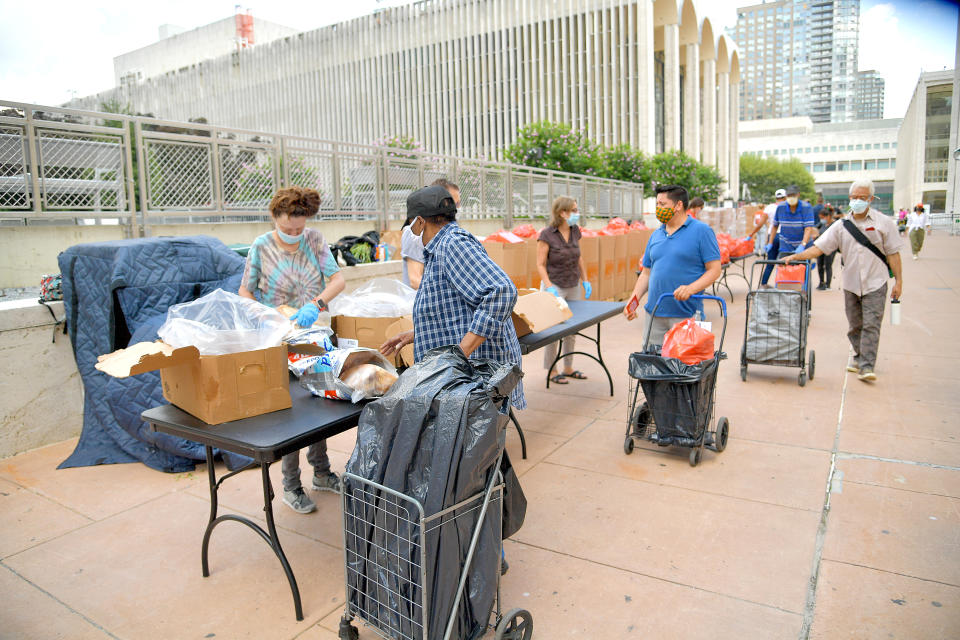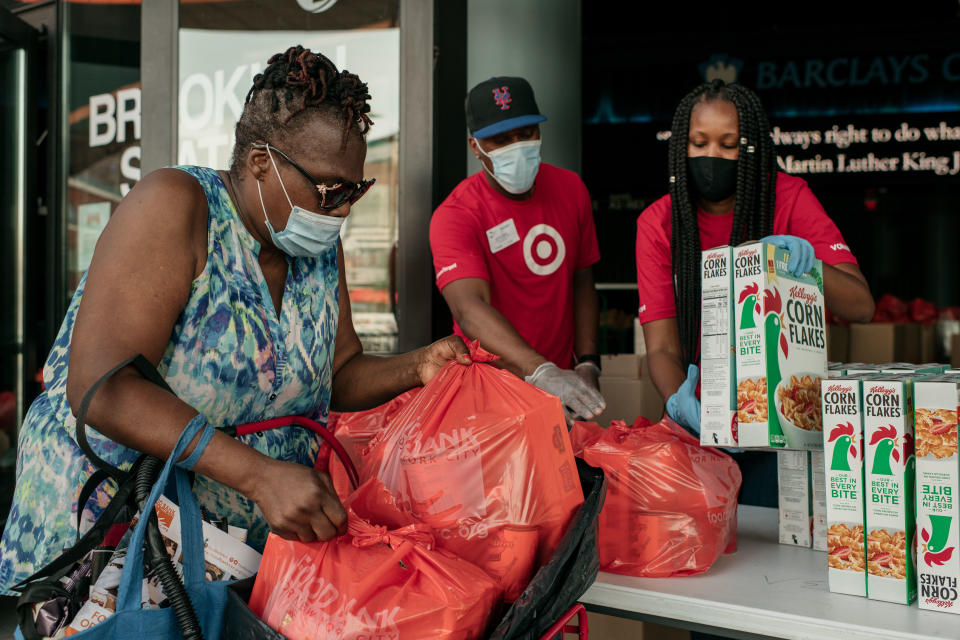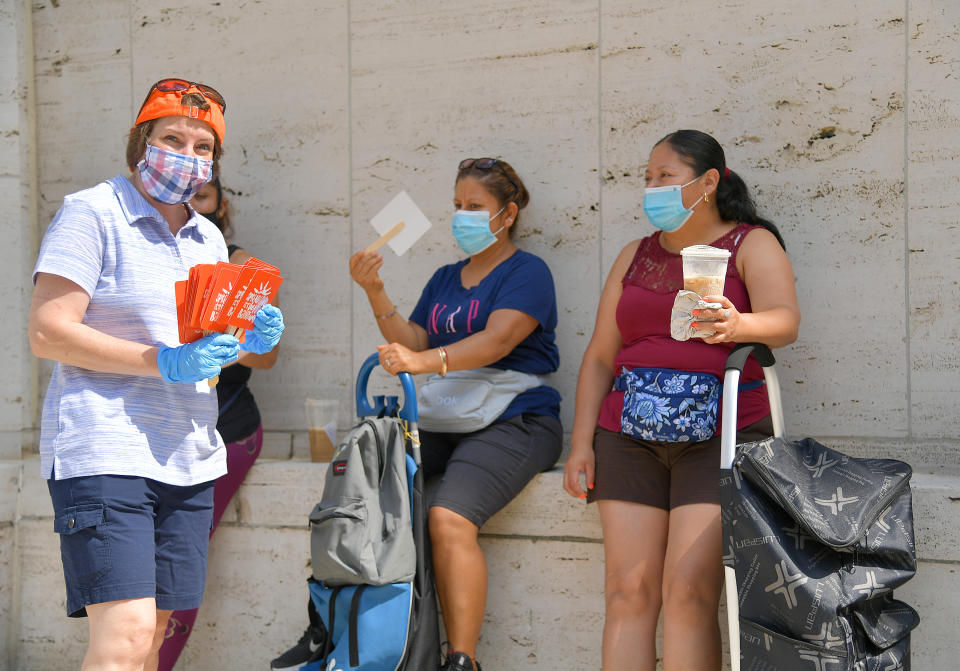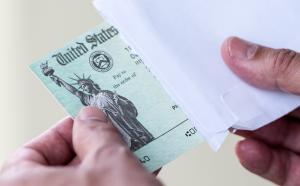'Money, Honestly' podcast: Battling food insecurity amid the pandemic
The COVID-19 pandemic has laid bare the nation’s food insecurity crisis.
Over the months of April and May, nearly 40 million Americans applied for unemployment insurance benefits because their jobs were eliminated or furloughed as much of the nation shut down to slow the spread of the coronavirus.
At a time when millions of Americans were struggling with this job loss, they were also hungry.
Government-funded food assistance programs like SNAP (Supplemental Nutrition Assistance Program) saw droves of new applicants. But that didn’t meet the need.
Food banks in the country’s largest cities of New York, Los Angeles, Chicago, Houston, and Miami, all saw increases in demand nearly triple and some cities couldn’t serve their hungry populations.
Demand for SNAP benefits and assistance from food banks has since decreased, but only in cities where active COVID-19 cases are declining. As the additional $600 weekly unemployment insurance benefit is set to expire on July 31, food banks across the nation are braced for another influx of clients and don’t foresee demand letting up before year’s end.
In the latest episode of the Money, Honestly podcast, Cashay editor Janna Herron discusses with reporter Stephanie Asymkos on the intersection of pandemic-era food insecurity and unemployment and what it means for the upcoming school year.
Their conversation is based on Stephanie’s ongoing reporting on the topic.

[AUDIO TRANSCRIPT]
Janna Herron: Hi, this is Money, Honestly. I'm Janna Herron, and today Stephanie Asymkos, a reporter on my team at Yahoo Finance and Cashay is joining us. We'll be talking about growing food insecurity in the coronavirus pandemic.
Stephanie, thank you for joining us.
Stephanie Asymkos: Hi, Janna.
JH: So this is kind of a sad topic. One of the things that we have seen since the pandemic started, especially in the very beginning, and I would love for you to tell us what you saw and found, is that a lot of people aren't getting the food that they need for their families.
SA: That's right. This country has a major food insecurity problem that the coronavirus has really just shined a very harsh, fluorescent, terrible light on. And we're seeing this breakdown between food insecure people, the unemployment system, the strain on our nation's food banks, pantries and kitchens, and then the problems with the government aid for food assistance. And then on top of all of that, there has been a massive breakdown in the grocery supply chain for the country. So, just a little bit of a problem going on.
JH: So a lot of factors coming together at the same time, a perfect storm for food insecurity.
SA: Absolutely.
JH: So let's go back to the beginning, or around April, when you were looking into people filing or applying for food stamps. What did you find at that time?
SA: Right. So in April, that was really the height of unemployment. I think we were over 20 million Americans who filed for unemployment and that was making the big splashy headline. But what was also happening behind the scenes is that those people were also applying for food stamps. And food stamps, we use it colloquially, but it's actually SNAP. And SNAP is an acronym that stands for Supplemental Nutrition Assistance Program. And that is the government's federally funded food assistance program for individuals and households that are low income or just non-earners right now.
JH: And does the federal government administer this program, or is it done through states?
SA: The overarching agency is the USDA. However, each of the 50 states administers its own program and sometimes it goes by SNAP, or other countries, geez. Hang on. Let me pull it together.
JH: Start all over.
SA: Yeah. Sometimes it's known as SNAP. Other states have other names for it. I know for instance, California calls it CalFresh. That all means the same thing. It is government food assistance.
JH: Okay. And then in April you said you looked at six or seven different states and you found that all of them had a huge increase in applications from mid-March to mid-April, right?
SA: Yes. California and Texas reported a 40% and then 102% respectively year-over-year increase in applications in March. Nevada and Rhode Island, their applications jumped 23% and then 77% just compared to the 30-day previous period. Louisiana and New York also saw their applications double and sextuple in March.
JH: Okay. Interesting. And you caught back up with some of those states recently to find out what was happening with the food stamps or the SNAP programs now. And what did you find out?
SA: I did. All of it mirrored where COVID is spiking and then where COVID is dropping. So, for instance, in New York, I mentioned that New York SNAP applications doubled in March. And actually, because New York is past its peak and states like Florida and California have overtaken as the new nation's epicenters and New York's getting its act together now, SNAP applications have actually decreased, which is wonderful. And that's a testament to just New Yorkers getting back to work, getting income again, which is wonderful. However, states like Louisiana and Texas, where we see that COVID is just ravaging communities and cities, SNAP applications are up again and have stayed at that same bar that was first hit in March and April.
JH: Right. Because in March and April, that's when we, nationally, there was that shut down so nobody was going to work. Then you got that increase in people needing food assistance. And then those states started to open back up and now they, while not shutting down again necessarily, they're definitely scaling back their re-openings.
SA: Yes. There are people going back on a lot of the measures that we know now and we can see clearly that they were prematurely lifted. It means that, say someone who worked as a server in a restaurant was laid off mid-March, April time, went back to work, say someplace like Houston, and now they might be out of work again because bars and restaurants are re-closed.
JH: Right. Right. Okay. That makes sense. So like you said, you're seeing that rise in food need in those areas. What about the food banks? You had talked about those earlier. What role are they playing? What did they see before and now?
SA: So food banks, my heart beats for food banks right now because they are all 501(c)(3), which means they are tax-exempt, charitable organizations. And they do not charge anyone who shows up in search of a meal or anyone who is hungry. So there is no expectation of repayment or donation. And what has happened is that people who don't meet that threshold for SNAP benefits, their hunger doesn't go away. So they will lean into food banks to bridge that gap for them and meet that need. So I've been talking to food banks, the first wave, I talked to them in April and I talked to the largest cities in the nation.
And then they all said that demand was nearly 200% of what it was pre-pandemic. I talked to the president of the Houston Food Bank and said that there was so much demand they couldn't meet at all because they just weren't prepared. There were people in cars that were lined up that stretched for miles, and it's so heartbreaking because it's very real. We all get hungry, I get hungry every couple hours, everyone does. And to be without food is terrible, on top of all of this.
JH: Right. Yeah because they're already stressed that you're dealing with when it comes to your health. And then if you can't get enough to eat, that makes it even worse. Especially if a family of children and that's got to be just devastating.

SA: Yeah. Well, the child piece is the most interesting because since school's closed in mid-March in a lot of parts of the country, and there's a good percentage of children, school children, who are on free and reduced lunch, families and households really relied on schools to feed their children for those five meals a week at minimum for lunch. And then a lot of other districts offer breakfast, lunch, and then either an afternoon snack or will send children home with a meal starter kit. So the absence of that has been so devastating, particularly in Los Angeles County, where I talked to the president of the Los Angeles Regional Food Bank.
JH: Right. And that's a good point because school is around the corner, but the reopening of school is very, depending on where you are, there's either all remote, which I think in Los Angeles, they're doing all remote or it's going to be some kind of blended type where you have some in-person instruction and the rest remote, which is what New York City is trying to do. So that food insecurity problem for children might persist in a place like LA, where you're still remote.
SA: Yes. And it's also an issue in South Florida. It's really awful. Schools have done a great job of giving out lunches and having people come to the schools and do, they call them grab and go distributions. But not everyone has transportation available to them that they can get to the schools. Children aren't being bused anywhere. And the president of the LA County Food Bank just doesn't think that it really has the same impact as children attending school live.
JH: Right. Yeah, and that's really terrible. The other thing that I wanted to talk about, which is happening now, which relates to all the things that you told us about, regarding food stamps and food insecurity and the food banks, is that a lot of people who lost their jobs were able to get unemployment benefits. Up until this week, they got an extra $600 on top of the unemployment benefits that they would get regularly from their state.
And that was a huge increase for a lot of people. And really in some cases, people actually got more in unemployment benefits than they earned regularly. And that helped people from feeling or experiencing food insecurity. But now those benefits are set to go away. And we're not sure what's going to be replacing them, whether it's going to be anything or a reduced amount. So when you talk to people about that expiration, what did you find?
SA: So the food banks are very well aware of this. We're recording this on July 29th, that $600 is set to expire on July 31st. So we're really right there. The food banks are prepared for another surge in clients seeking assistance. But the thing that they really need right now is just more food. They have the volunteers, they have the power to serve these massive populations. And the food banks I connected with were some of the largest cities in the country, Houston, Miami, Los Angeles. And they serve really wide areas besides that Metro hub. So they're ready, but they just need more food.
JH: And when it comes to applying for SNAP, when you had that extra $600, is it possible that a lot of people beforehand actually, because of that $600, didn't qualify for that food assistance?
SA: Yeah. It was kind of a paradox, right? Where there were people receiving unemployment benefits, plus the $600 weekly, that was automatically tacked on regardless of how much you were earning in unemployment. So you're right. In some cases, people were out earning what they previously did pre-pandemic. So in the absence of the $600, it's really going to really knock some households and some individuals down in income. But it could have put you over the threshold for qualifying for SNAP benefits, meaning now in its absence, depending on how many dependents you have, meaning how many people are in your household, how many mouths are there to feed and depending on what state you live in, because we all know that states have different standards of living, different costs of living, and they all have different thresholds for SNAP income benefits. So depending on where you live, how many people are in your family and how much you earn, you might qualify now, if you didn't qualify before.
JH: That's interesting. So did you talk to some state SNAP agencies and ask what they are expecting?
SA: I did. And I connected with agencies in California, Louisiana, New York, Texas, and they all have said that they are able to meet the funding obligation because funding is split, some way it's split between the federal government and the states. So the states are ready and they can make their contributions, but there is still a very heavy caseload in some of these states. And I actually talked to an economist about this and he really forecasted, is there really going to be a surge of people. And he actually predicted that there wasn't, that it's going to take a lot more time. And it's really just that people are going to have a lot more urgency for income right now. But the people in that Venn diagram of people who receive unemployment benefits and then the people who receive government food assistance, that intersection, he said it's a pretty small slice of people.
JH: Okay. Well, that's interesting. And like you said earlier, before, like that that's where the food banks step in. If you don't qualify for SNAP assistance, then the food banks get that portion of people who still need some kind of help with food.

SA: Yes. And when I did my first round of reporting about the people who are visiting food banks in need of assistance, many of them said that there were people there who had never ever before sought the help of a food bank. So this pandemic has really increased that food insecurity and who, I guess maybe we previously thought of as food insecure, has really widened that net because it's people that are first time clients.
JH: Right. And this is also happening at a time, like in the last couple of months we saw rising food prices. I mean, I know going to the grocery store, certain things I pay a lot more for than I did before. So that just makes things even worse.
SA: Definitely groceries are really expensive right now. And not everyone, not every household, not every individual can afford that luxury of online shopping because there's a premium for online food shopping through companies like Instacart or Amazon. So not every family can afford that. And even when you're in store or you buy your groceries online, they are much more expensive. And we know this because there has been a total breakdown in the supply chain for groceries in the country. Earlier in the pandemic, there were workers in plants that were shut down. So there was less people to produce and package our food and then there were less people to move all of our food around. Just thinking about it, I live in Brooklyn and it's like any time I want to eat like a pineapple or a banana, that gets imported. We don't grow those types of foods here. They all get brought in and they all come from somewhere.
And so there was a breakdown there, and then there were more people food shopping. So there were more things. So all of the items that grocers donate to food banks, people were buying. So there was less available to donate to food banks and then food companies were rolling back and scaling back. So they weren't able to donate as much to food banks either. So food banks were really, really pinched in that equation as was the consumer, or is the consumer because groceries are still pretty expensive.
JH: Right, right. Yeah, no, I think I just saw not that long ago that the USDA forecasts grocery prices to rise by 3% this year, which would be the largest annual increase since 2011. So yeah, that doesn't make anything any easier. So say if I am in a situation where I might need some food assistance, can you walk us through how to sign up for SNAP?
SA: Yeah. Depending on where you live, each state operates with its own set of eligibility guidelines. And so you can file your application either online or by mail. Personally, my advice is to go online just so you don't have to deal with just the lag that snail mail provides. But most states right now are trying to approve or deny applicants within 30 days, which is really what they're bringing in, like Louisiana for instance, brought in more caseworkers. So more caseworkers means that more people can get their approval or denial faster. If you are in dire, dire, shape, and dire needs, some states will offer expedited benefits to you that can get to you within seven calendar days, which I know sounds like an eternity when you're hungry and your family is hungry.
But in that case, that's when you would visit a food bank. But you should gather all of your financials and your personal information and those who are also in your household. So things like social security numbers, identity. Right now, SNAP is only available to US citizens. So you would need your proof of US citizenship and then proof of income and expenses. So once you have all of your documentation, then you can have a more seamless application process because you won't be digging for anything.
JH: Right, right. What happens if you all of a sudden get a job?
SA: Okay. So SNAP benefits are actually issued monthly, whereas unemployment benefits are issued weekly. But at any case, the staff benefit is open-ended. Whereas unemployment, you have to reapply. I believe it's every two weeks, at least that is for New York. But any change in income, you, as a recipient, are required by law to report.
JH: Gotcha. And then how will you get your SNAP benefits? Do they send you a check? Do you get a direct deposit? How does that work?
SA: It is very 21st century. You actually get a card, it's called an EBT card, which stands for electronic balance transfer. And it looks and feels just like a credit card or a debit card. And it can be used at farmer's markets, grocers, any place that sells food. And like I said, the benefit is open-ended. So on a certain day of the month, your entire monthly allotment will just automatically transfer to that EBT card and you'll be good to go.

JH: All right. So then there's no stigma or you don't feel weird going to the grocery store and having this card, if it looks like a debit card or a credit card.
SA: No. And I actually talked to a young man who is in his thirties. I shouldn't say that young man, that sounded like a grandma. Hang on, let me think. He was a sweet boy. All right.
I actually talked to someone who was a server and working in Rhode Island and he's in his thirties. And he applied and was using SNAP benefits for the first time in his life. And he actually said to me that there's no stigma at all. The only person who knows that it's an EBT card is the cashier. And when you're at that little space at the cashier station and checking out, there's no one that's looking. It's really just you in the cashier. And if you still even feel embarrassed or there's a twinge of anything there, just go for the cashierless checkout if that's available in your grocer.
JH: Right. That's really good advice. And no one should feel shame. Everybody is going through a very difficult time, one way or another during this pandemic. And some people are bearing the brunt of it. And so they might find themselves relying on these resources, either SNAP or food banks for the first time. But when things are over, there's always a chance to pay it forward and donate to those food banks when you can.
SA: Right. And they're all there because people need them. So make use of the resources because they're there to be used.
JH: Well, thank you, Stephanie, for outlining this and telling us what's going on and for joining us today on Money, Honestly.
Stephanie is a reporter for Yahoo Money and Cashay, a new personal finance website. Follow her on Twitter @SJAsymkos.
Read more information and tips in our Budgeting section






